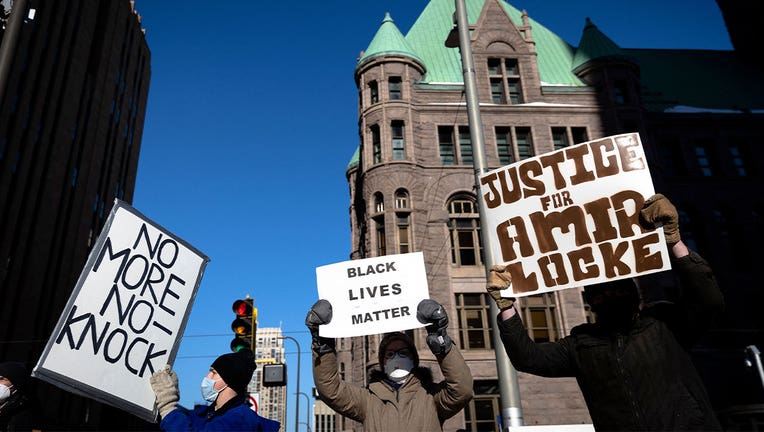State of Black Minnesota: Report sheds lights on inequalities

Demonstrators hold "Justice for Amir Locke", "Black Lives Matter" and "No More No-Knock" signs during a rally in protest of the killing of Amir Locke, outside the Hennepin County Government Center in Minneapolis, Minnesota on February 5, 2022. - Auth (Getty Images)
(FOX 9) - The "State of Black Minnesota Report 2021" takes a deep dive into the stark racial disparities in Minnesota in hopes that the community can come together and make things better for everyone. It features not only the struggles of the Black community but the triumphs and the ways the Black community has thrived.
"If we're going to be honest about what it takes to address and to overcome the inequities … we have to begin by acknowledging that they didn't happen in a vacuum or by accident. They happen through intentional structured means, through policies and practices that were intended to be openly specifically racist," said Steven Belton, president and CEO of the Urban League Twin Cities.

State of Black Minnesota: Report sheds lights on inequalities
A report released on Thursday is shining a light on the challenges and inequalities that Black people in Minnesota face.
The 37-page report featured expert analysis in seven key metrics of Black life: health and wellness, criminal justice, generational wealth, education disparities, business, arts and culture and faith.
"(The report is) coming at an important time when we know that Minnesota has among the worst disparities in homeownership and health, education and employment in the country," Belton said.
The Urban League said significant and encouraging change happened in 2021, but there are still glaring historical inequities:
- Black residents live on average seven years fewer than their white neighbors.
- Black men continue to be killed at twice the rate of white men at the hands of police.
- In Minnesota only 25% of Black families own a home compared to 76% of white families.
- Minnesota’s Black students say they feel cared for in school less often than their white counterparts.
- Before the pandemic, the number of African American businesses grew faster than non-minority firms in Minnesota, and 44% of all Black businesses were female owned.
- Minnesota’s Black artists and arts organizations galvanized the nation with new artistic expressions after the murder of George Floyd showcasing a sense of urgency, community strength and resiliency.
- Black centers of faith have expanded their support for community members, adding critical health, economic and social justice services during COVID-19 and following the murder of George Floyd.
Dr. Rachel Hardeman, the director for the Center for Antiracism Research for Health Equity at the University of Minnesota School of Public Health, is the expert who provided analysis in the section of the report about health and wellness among Minnesota’s Black community.
"Minnesota consistently ranks as one of the healthiest states in the nation. However, those averages don't tell the whole story for our state," she explained. "Minnesota actually has some of the most significant health inequities in the country, particularly when you look at Black versus White residents."
Hardeman explained that racism causes stress in people’s lives and can even impact birth outcomes for pregnant mothers.
"The chronic stress due to being disadvantaged, due to not having access to all of the things that you need, due to being discriminated against in the workplace or in other places -- that causes wear and tear on the body," Hardeman explained. "That stress eventually wears the body down, and we see this in pregnancy and childbirth."
She explained further that her research shows living in Minneapolis neighborhoods with more police patrols can affect birth outcomes for pregnant mothers.
The Urban League also released a report called the "Minnesota Equity in Action Framework," which lays out a plan to help improve education. The framework consists of five priorities each with a prescription for change:
- Address access and resource inequities: When children are provided with rich learning opportunities they thrive and the achievement gap closes.
- Recruit and retain a diverse, culturally responsive teaching force: Students of color taught by teachers of color are more likely to have positive gains in test scores, are less likely to be disciplined, and more likely to be identified for gifted programs.
- Eliminate disproportionate suspension and expulsion rates: Students who are subject to exclusionary discipline practices suffer lower academic achievement, higher truancy, higher dropout, higher contact with the juvenile justice system, and lower local and state economic growth.
- Embed cultural competence in system-wide educational practices: There are important educational benefits–cognitive, social and emotional–for all students who interact with classmates and teachers from different backgrounds.
- Engage and partner with parents/families and community allies: School, family and community partnerships result in critical resources, intellectual capital, and new perspectives that districts and schools can leverage to educate all students more equitably.

